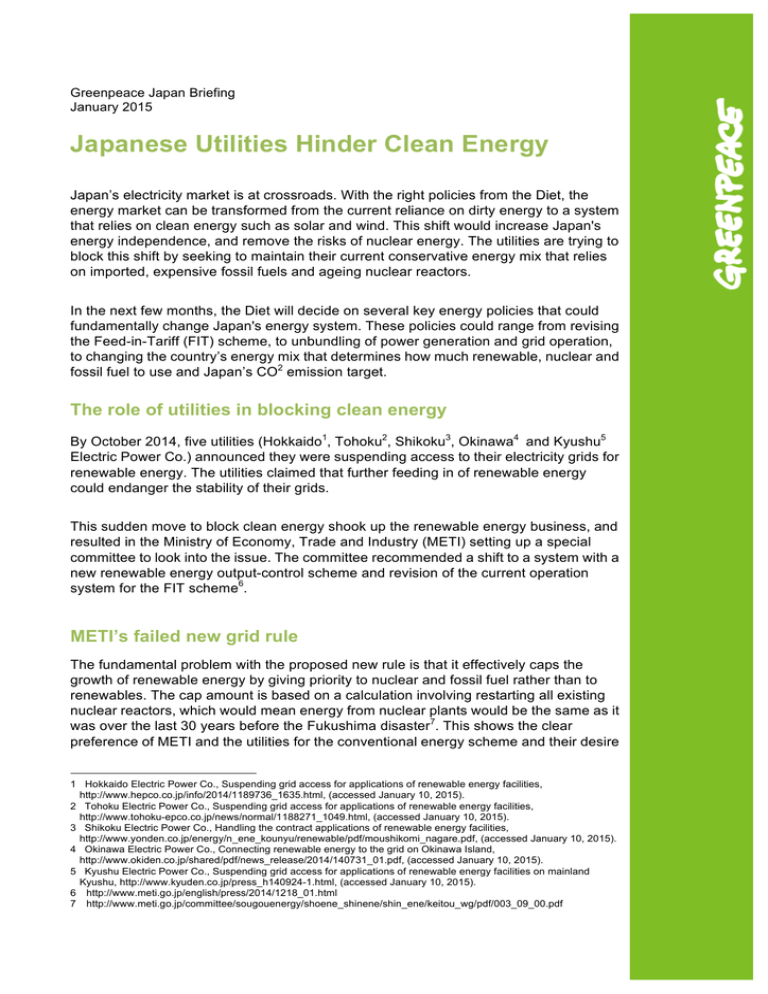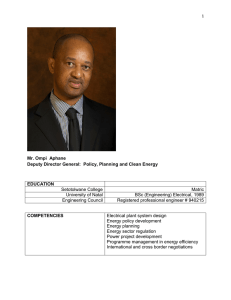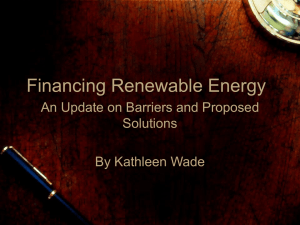Japanese Utilities Hinder Clean Energy
advertisement

Greenpeace Japan Briefing January 2015 Japanese Utilities Hinder Clean Energy Japan’s electricity market is at crossroads. With the right policies from the Diet, the energy market can be transformed from the current reliance on dirty energy to a system that relies on clean energy such as solar and wind. This shift would increase Japan's energy independence, and remove the risks of nuclear energy. The utilities are trying to block this shift by seeking to maintain their current conservative energy mix that relies on imported, expensive fossil fuels and ageing nuclear reactors. In the next few months, the Diet will decide on several key energy policies that could fundamentally change Japan's energy system. These policies could range from revising the Feed-in-Tariff (FIT) scheme, to unbundling of power generation and grid operation, to changing the country’s energy mix that determines how much renewable, nuclear and fossil fuel to use and Japan’s CO2 emission target. The role of utilities in blocking clean energy By October 2014, five utilities (Hokkaido1, Tohoku2, Shikoku3, Okinawa4 and Kyushu5 Electric Power Co.) announced they were suspending access to their electricity grids for renewable energy. The utilities claimed that further feeding in of renewable energy could endanger the stability of their grids. This sudden move to block clean energy shook up the renewable energy business, and resulted in the Ministry of Economy, Trade and Industry (METI) setting up a special committee to look into the issue. The committee recommended a shift to a system with a new renewable energy output-control scheme and revision of the current operation system for the FIT scheme6. METI’s failed new grid rule The fundamental problem with the proposed new rule is that it effectively caps the growth of renewable energy by giving priority to nuclear and fossil fuel rather than to renewables. The cap amount is based on a calculation involving restarting all existing nuclear reactors, which would mean energy from nuclear plants would be the same as it was over the last 30 years before the Fukushima disaster7. This shows the clear preference of METI and the utilities for the conventional energy scheme and their desire 1 Hokkaido Electric Power Co., Suspending grid access for applications of renewable energy facilities, http://www.hepco.co.jp/info/2014/1189736_1635.html, (accessed January 10, 2015). 2 Tohoku Electric Power Co., Suspending grid access for applications of renewable energy facilities, http://www.tohoku-epco.co.jp/news/normal/1188271_1049.html, (accessed January 10, 2015). 3 Shikoku Electric Power Co., Handling the contract applications of renewable energy facilities, http://www.yonden.co.jp/energy/n_ene_kounyu/renewable/pdf/moushikomi_nagare.pdf, (accessed January 10, 2015). 4 Okinawa Electric Power Co., Connecting renewable energy to the grid on Okinawa Island, http://www.okiden.co.jp/shared/pdf/news_release/2014/140731_01.pdf, (accessed January 10, 2015). 5 Kyushu Electric Power Co., Suspending grid access for applications of renewable energy facilities on mainland Kyushu, http://www.kyuden.co.jp/press_h140924-1.html, (accessed January 10, 2015). 6 http://www.meti.go.jp/english/press/2014/1218_01.html 7 http://www.meti.go.jp/committee/sougouenergy/shoene_shinene/shin_ene/keitou_wg/pdf/003_09_00.pdf 1 to protect it. The proposed new rule is closed for a 20-day period of public comment which ended on 9 January. The new rule could be announced as soon as middle of the month and implemented from the end of January. METI claims its new rule supports the further growth of renewable energy. However, the rule allows the utilities continued freedom to power their grids as they wish, with mainly polluting nuclear and fossil fuels, and feed renewables into their grids as a supplementary energy source only.8 What’s more, the new rule expands the utilities' ability to curtail excess output of clean energy without any requirement to compensate suppliers of renewable energy, including all households that supply solar energy (except the supplying area of Tokyo, Chubu, and Kansai Electric Power Co.). This gives utilities even greater leeway to block renewables. It is a sign that the utilities have reached the limit of their “comfort zone”, that is to say the amount of renewable energy they consider suitable for their grids. Their view of capacity is incorrect, in particular when considering: - the range of technological adaptation measures available to extensively increase the capacity of grids; - that some European grids are able to integrate a much larger amount of renewable energy than the Japanese ones while operating under similar conditions; - that the Japanese utilities applied a narrow definition for their capacity limits for feeding in renewables, choosing criteria that reduce the amount of renewable energy their grids can actually integrate; - that all nuclear power plants are currently closed down, and it is uncertain if and how many will be restarted, leaving a large amount of free capacity which renewable energy could fill. A narrow definition of capacity limits The utilities ignored that capacity limits can be defined in various ways and applied a narrow definition. The electricity companies suspended access to their grids, claiming that the output of approved (but not yet connected) renewable energy projects would exceed demand during periods of low electricity demand and that, once this overcapacity was connected to the grid, it could potentially lead to power loss. This approach largely exaggerates the challenge to integrate variable renewables in the grid. The capacity to integrate variable renewables is much larger for the following reasons (see annex for further details): - solar panels and wind turbines never operate at 100% of their total installed capacity; - thousands of operational units at solar and wind power plants in a region never run simultaneously at maiximum power; - peak generation of variable renewables occurs only a fraction of time during a year; Also, there is a huge gap between the number of approved solar projects and the ones that actually operate. Since Japan's FIT scheme began in July 2012 to the end of March 2014, only about 10% of the approved capacity of solar photovoltaic (PV) projects was realized.9 The approval rate is, therefore, not an appropriate number to use for assessing how much renewable energy the grids are able to integrate. In addition, the process from approval to actual generation of renewable energy is time consuming and doesn’t happen at once, especially when a large number of projects 8 While feeding in and purchase of renewables are obliged, renewables are not the first in line and there is no duty to install the maximum amount. Asami Takehama, “Grid integration of wind and solar energy in Japan and Germany: 'Top-down' grid operation and‘Bottom-up th th and flexible' grid operation”, 19 REFORM Group Meeting, Salzburg, September 4 , p. 4. 9 METI, Status and tasks regarding renewable energy, (METI 2014), p. 18. http://www.meti.go.jp/committee/sougouenergy/shoene_shinene/shin_ene/pdf/001_03_00.pdf. 2 are in the waiting line. Moreover, the utilities have ignored a range of measures available to balance peaks and troughs of fluctuating renewable energy, from easier and cheaper ones—such as pumped-storage hydropower and better usage of existing interconnection lines among regions—to more sophisticated and more costly ones—such as batteries. The criteria the utilities have used to judge capacity limits for renewables were not realistic. Japan's utilities have adopted an energy policy that is “conservative”. They grant access to renewables, but give priority to fossil fuels and nuclear. The proof is visible in the small share of renewable energy in their energy mix. Renewables accounted for only 2.2% (excluding large hydro water plants) in 2013.10 In fact, Japan's utilities have a large amount of free capacity available that could be filled with renewable energy, since all of nuclear power plants are currently shut down. Japan’s grid capacity compared to Europe’s Denmark, Spain and Germany have proven that grids have a huge capacity to effectively integrate renewable energy. In 2013, wind energy supplied about 33% of Denmark's total electricity consumption11—while Japan’s wind energy provided as little as 0.5% of total supply.12 China installed 342 times more wind power than Japan in 2013.13 While Japan added as much as 7 GW solar PV installations in 2013, the second largest amount after China, its PV systems reached a total installed capacity of 13.6 GW, which is still 2.6 times smaller than Germany’s with 35.8 GW.14 Japan is often referred to as an energy island since—unlike Europe—its grids lie isolated from other countries. Also, Japan’s cross-regional interconnection capacity is said to be limited, putting another break on balancing peaks and troughs of fluctuating renewable energy. Figure 1: Comparison between Japanese and European grids 10 METI, Status and tasks regarding renewable energy, (METI, 2014), p. 4. http://www.meti.go.jp/committee/sougouenergy/shoene_shinene/shin_ene/pdf/001_03_00.pdf. 11 Energinet, 2013 was a record-setting year for Danish wind power, http://energinet.dk/EN/El/Nyheder/Sider/2013-var-et-rekordaar-for-dansk-vindkraft.aspx, (accessed November 24, 2014). 12 GWEC, Global Wind 2013 Report, (Brussels: Belgium, Global Wind Energy Council, 2014), p. 60. http://www.gwec.net/wp-content/uploads/2014/04/GWEC-Global-Wind-Report_9-April-2014.pdf. 13 China installed 16,100MW in 2013 compared to Japan with 47MW, see GWEC, p. 42. 14 IEA, Trends 2014 in Photovoltaic Applications, (International Energy Agency, 2014), p. 18, 26. http://www.iea-pvps.org/fileadmin/dam/public/report/statistics/IEA_PVPS_Trends_2014_in_PV_Applications_-_lr.pdf. 3 These arguments are incorrect, given that some of the European grids integrate a much larger amount of renewable energy even though their interconnection capacity is comparable to the Japanese one. For example, Spain’s grid, due to its geographical location on the Iberian Peninsula, is nearly excluded from the European one. Despite this, Spain's wind power capacity reached 22,959 MW in 2013, about nine times as much as Japan’s.15 According to a study by Prof. Yoh Yasuda, the Kyushu grid has almost four times as much interconnection capacity as the Spanish grid, and west Japan was better interconnected than Denmark or Germany (see figure 2). This comparison between Japanese and European utilities shows the need for Japan's utilities to explain and prove why electricity companies in other nations are able to feed in large amounts of renewable energy and they don’t. Figure 2: Interconnection capacity ratio per peak demand of Japan and Europe (in % of GW, 2012)16 Liberalization of the Japanese electricity market Japanese monopolistic utilities assume that growth of renewable energy, spurred by the liberalization of the Japanese electricity market, will lead to a gradual decline in their revenues—as this is what happened to their European counterparts17. Liberalization of the European electricity market has demonstrated over the last 10 years that increasing wind and solar output pushes down prices on wholesale electricity markets. This benefits especially large industrial consumers, while European utilities, which earn profits from their own coal, gas and nuclear power plants, suffer. A higher share of solar and wind energy also means less output from their coal and gas plants is needed. Thus, solar and wind power shift profits from utilities to households and generators of renewable electricity. 15 see GWEC, p. 16. 16 Yoh Yasuda, Japan Renewable Energy Foundation REvision 2014 –Experts’ Meeting, February 24, 2014 Current Status of Grid Integration Issue in Japan. 17 Beyond Nuclear – The Tripple Challenge Facing Japanese Utilities, (Greenpeace International, February 2013) http://www.greenpeace.org/international/en/publications/Campaign-reports/Nuclear-reports/BeyondNuclear/ 4 Conclusion Japan's utilities currently maintain their conservative energy mix, stalling the possible growth of renewables. To counteract this, renewable energy must be given priority access to grids and dispatch before other energy sources. Japan’s electricity market is at a crossroads. The right path can be taken beginning of this year when the Diet decides on some key energy policies including the so-called “unbundling” of the 10 utilities—the separation of electricity generation, transmission and distribution. If the government fails to bring about an effective and comprehensive unbundling, the control monopolistic utilities over the electricity market would persist. The sudden move by the utilities to suspend further access to their grids should be seen as a clear warning to Japanese legislators. It raises the question of whether the utilities acted out of self-interest to protect their regional monopolies. An effective unbundling is an absolute requirement for fair competition as well as for sustainable and affordable electricity generation in upcoming years. Effective unbundling is needed to unlock strong growth of renewables in the Japanese electricity market. From a national and a global perspective, renewable energy is Japan’s energy paradigm of the future, especially considering the country’s rich renewable energy resources.18 Japan needs a clear-cut energy shift towards 100% renewable energy19 to be internationally competitive tomorrow, to avoid increasing risk of another nuclear disaster, to reduce its dependence on fuel imports, and to decrease green house gas emissions. Therefore, the utilities have a national responsibility to restructure their polluting energy mix, abolish inflexible energy sources, like nuclear power, and make clean renewable energy their core energy source.20 If Japan doesn’t move towards 100% renewable energy, there is a risk that the short-term thinking of a few monopolistic utilities to maximize their profits will stall the growth of renewable energy and compromise economic growth in the future. A policy shift towards renewable energy is essential on a planet that is reaching its ecological boundaries. Key Greenpeace recommendations • Japan must set a specific and ambitious national target to increase renewable energy; • Japan must give priority access and dispatch for renewables before other energy sources; • Unbundling of electricity generation, transmission and distribution must be comprehensive and effective; • New policies must optimize the grids towards full market integration on the national level while breaking down the monopolistic structure in regional markets; • Inflexible nuclear power plants must be replaced with a combination of variable renewable energy sources with flexible gas plants as a ‘bridge’ (as flexible gas plants are able to quickly respond to electricity spikes and dips); • Investment in energy efficiency and demand management must be made. 18 Ministry of the Environment, Report on potential to introduce renewable energy, 2010, http://www.env.go.jp/earth/report/h23-03/, (accessed January 10, 2015). 19 Greenpeace and EREC have worked out clear pathways to a shift from nuclear energy and fossil fuels to 85% renewable energy by the year 2050. Greenpeace/European Renewable Energy Council, The Advanced Energy Revolution, (Greenpeace/EREC 2011), p. 21. http://www.greenpeace.org/japan/Global/japan/pdf/er_report.pdf 20 Unlike conventional energy sources, solar and wind energy generates a fluctuating energy output. Feeding in a greater amount of solar and wind energy demands therefore that the utilities restructure their conventional, inflexible energy mix and implement flexible energy sources that can balance the fluctuations. 5 ANNEX The deeper context of grid capacity There are different ways to assess the capacity of a grid to integrate photovoltaic (PV) and wind power. In the Japanese context, the assessment is often based on the ratio of total installed capacity of wind and PV to low electricity demand. This approach is not suitable when figuring out how to introduce large amounts of variable renewables, as it overstates the problem for at least six reasons. The first set of reasons is about the generation of variable renewables such as solar and wind, the second set about the wider electricity system and its ability to integrate renewables. A. Generation of variable renewables 1. Solar panels and wind turbines never operate at 100% of their capacity The actual connected amount of variable renewables (in MW) is significantly lower than the total installed capacity. • Solar and wind power are generated by thousands of units, all of which are never operational at the same time. • The operational units never run simultaneously at maximum power, as solar or wind conditions always differ over a large area. • Both wind and solar have different profiles during the day; record generation of wind and PV will not occur at the same time. 2. Record-high generation of renewables will rarely coincide with low demand The historical records of wind power generation on the Iberian Peninsula (Spain and Portugal) in 2013 illustrate points 1 and 2: • As shown at the Fiture 3, record wind generation (all-time high) was noted on February 6 at 15:49 when wind production reached 17,056 MW.21 At a 10-minute resolution, wind power generated 17,014 MW between 15:50 and 16:00 or 50.6% of the total demand.22 The total installed capacity in 2012 was 22,617 MW and 22,854 in 2013.23 • If generation power is taken as a percentage of production at a 10-minute resolution, wind power reached 67.1 percent between 2:50 and 3:00 on Dec 25th with 13,374 MW24, which is 58% of the 22,854 MW25 installed at the end of in 2013. On neither of the two dates with record generation (February 6th and December 25th, 2013) was low demand registered. 21 REE, The Spanish Electricity System 2013, annual report, (Madrid: Spain, Red Electrica De Espana, 2013), p. 15. http://www.ree.es/sites/default/files/downloadable/the_spanish_electricity_system_2013.pdf 22 REE, Electricity demand monitoring, https://demanda.ree.es/demandaGeneracionAreasEng.html 23 see REE, annual report, p. 59. 24 REE, Electricity demand monitoring, https://demanda.ree.es/demandaGeneracionAreasEng.html 25 see REE, annual report, p. 59. 6 Figure 3: Real time electricity demand tracking for 6th February 2013 by Spanish grid operator Red Electrica (REE) which shows 50.6% of total electiricty demand of Spain (in ten minutes period) was generated by wind power. 3. Exceptional peak generation of variable renewables is not representative to understand grid capacity • Output of larger PV plants and wind farms can technically be curtailed in exceptional situations in case of grid congestion (excess of electricity supply in the grid). This is a simple technical measure. The issue here is not technical but economic. If output curtailment increases to several percent of the annual generation, then the cost of renewable generation increases, as the installed PV or wind capacity is not used in an optimal way (more production is possible). Thus, curtailing peak generation needs to be minimized for economic reasons. • This can be illustrated by the duration curves for wind and solar PV. Duration curves show the hourly generation for each of the 8,760 hours in a year, which are ranked from highest on the left to lowest on the right on the X-axis. The power curve below represents the onshore wind power generation in Germany in 2013.26 The total installed onshore capacity was 33,658 MW at the end of 2013.27 The graph shows that the maximum generation from wind remains well below the total installed capacity, and more importantly, that the number of hours with a generation above e.g. 20,000 MW is limited. In the even more exceptional situation, where record generation of wind power would coincide with a record generation of PV and low demand, wind power could still be curtailed without significant economic loss if congestion were to occur. 26 Fraunhofer IWES, Wind Energy Report Germany 2013, (Kassel: Germany, Fraunhofer Institute for Wind Energy and Energy System Technology, 2013), p. 24. http://windmonitor.iwes.fraunhofer.de/bilder/upload/Windreport_2013_engl.pdf 27 see Fraunhofer IWES, p. 7. 7 Figure 4: Power curve of the onshore wind power generation in Germany in 2013 26 B. The wider electricity system 4. The flexibility of the residual load is crucial Both the Spanish and the German electricity systems still have a significant share of large-scale inflexible generation capacity (nuclear in Spain and nuclear and lignite in Germany). The inflexible generation conflicts with high levels of variable renewable generation, because the inflexible power plants cannot reduce their output quickly enough when there is grid congestion (due to oversupply). As a result, the output of renewables is curtailed. In order to avoid congestion, the inflexible generation power plants need to be replaced by e.g. flexible gas plants. 5. Interconnection between the regions controlled by the Japanese utilities should be taken into account in order to facilitate the integration of renewable sources. Given Japan’s large geographical area stretching up to islands, profiles of wind and PV generation differ greatly depending on the area. Power exchanges among those areas can level out peak generation from variable renewables in one region. 6. Storage capacity and demand management should be enhanced 8





